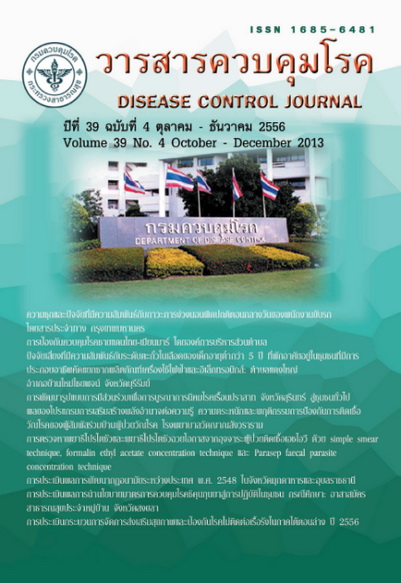Risk factors associated with blood lead level of under 5-year old children residing in community with electronic waste separating activity: Dangyui Sub-District, Banmaichaipoj District, Buriram Province
DOI:
https://doi.org/10.14456/dcj.2013.3Keywords:
Blood lead level, Children exposure to lead, Electronic waste separating careerAbstract
This analytical cross-sectional study aimed to study risk factors associated with blood lead level of children under 5-year old who are residing in community with electronic waste separation activity in Dangyui Sub-district, Banmaichaipoj District, Buriram Province during June-August 2013. The subjects were 132 parents of children, and the data collection used questionnaire which consisted of: (1) personal data such as gender, age, nutrition status, personal hygiene, underlying disease and occupation of parents, and (2) risk factors associated children lead exposure, such as: eating habits, food and water intake, child care place, containers for food and water, time span of residing in the village, house painting and battery use, distance of house from electronic waste separation plant, etc. The blood specimens 132 children were sampled to analysis by the Graphic Furnace Atomic Absorption Spectrometry method for blood lead level investigation. Analysis of data used descriptive statistics: frequency, percentage, median, minimum-maximum and the odd ratio and t-test statistics to explore relationships between blood lead levels and multiple variables. The study result showed that the children under study were female 51.52% with their ages of between 2.10-3.00 years 26.52%. Most of children were at normal nutrition status 75.00%, with underlying diseases 18.94%, their parents had primary school education 52.27%, the parents worked for electronic waste separation business 43.94%. Their median blood lead level was 3 (J§/dL (min-max = 1.50- 13.50 (jg/dL). When compared to the US CDC standard level at 5 |Jg/dL, the children blood lead level found to exceed the standard 14.40%. Further, when analyzing personal and exposure risk factors, those were not statistically significantly correlated with the blood lead levels (p>0.05).
Downloads
References
2. Untimanon, o. Relative contribution of potential pathway of household surface and family members's lead contamination in the homes of boatyard caulkers in southern Thailand: an experimental study. (Ph.D. Epidemiology). Faculty of Medicine. Songkla: Prince of Songkla University; 2009.
3. World Health Organization. Childhood Lead Poisoning. The WHO document production services, Geneva: World Health Organization; 2010.
4. Chomchai, C. Padungtod, C & Chomchai, S. Predictors of elevated blood Lead level in thai children: A pilot study using risk assessment questionnaire. J Med Assoc Thai 2005;88:53- 9.
5. กรมอนามัย. รายงานการสำรวจพัฒนาการเด็กปฐมวัย ประจำปี 2550 [ออนไลน์]. [สืบค้นเมื่อวันที่ 13 พ.ย. 2555]. แหล่งข้อมูล URL: http://hp.anamai.moph.go.th/ ewt_dl_link.php?nid = 251
6. สุกัญญา ฆารสินธุ์. รูปแบบการเลี้ยงดูเด็กอายุต่ำกว่า 5 ปี ของปู่/ย่า/ตา/ยาย ที่บริโภคสุราและไม่บริโภคสุราในอำเภอแห่งหนึ่ง จังหวัดขอนแก่น. (วิทยานิพนธ์ปริญญาพยาบาลศาสตรมหาบัณฑิต). บัณฑิตวิทยาลัย. ขอนแก่น: มหาวิทยาลัยขอนแก่น; 2555.
7. สำนักระบาดวิทยา กรมควบคุมโรค. สรุปรายงานเฝ้าระวังโรค 2554 เรื่อง พิษสารโลหะหนัก (heavy metal poisoning). กรุงเทพมหานคร: กรมควบคุมโรค กระทรวงสาธารณสุข; 2554.
8. Agency for Toxic substances and disease registry. Lead. Public Health Statement. [Retrieved Internet]. 2012 [cited 2012 Nov 2]; Available from http://www.atsdr. cdc.gov/ToxProfiles/tpl 3-cl -b.pdf.
9. Bi X, Thomas GO, Jones KC, Qu พ, Sheng G, Martin FL, et al. Exposure of electronics dismantling workers to polybrominated diphenyl ethers, polychlorinated biphenyls, and organochlorine pesticides in South China. Environ Sci Technol 2007;41:5647-53.
10. Huo X, Peng L, Xu X, Zheng L, Qiu B, Qi z, et al. Elevated blood lead levels of children in Guiyu, an electronic waste recycling town in China. Environmental Health Perspectives 2007;115: 1113-17.
11. สำนักโรคจากการประกอบอาชีพและสิ่งแวดล้อม. สรุปสถานการณ์ปัญหาโรคพิษตะกั่วในประเทศไทย. นนทบุรี: กลุ่มเวชศาสตร์สิ่งแวดล้อม สำนักโรคจากการประกอบอาชีพและสิ่งแวดล้อม กรมควบคุมโรค. (ไม่ได้ตีพิมพ์). 2555.
12. องค์การบริหารส่วนตำบลแดงใหญ่. สถานการณ์ปัญหาและการดำเนินงานแก้ไขปัญหาซากผลิตภัณฑ์เครื่องใช้ไฟฟ้า และอิเล็กทรอนิกส์ภายในตำบลแดงใหญ่. เอกสารประกอบการประชุมเชิงปฏิบัติการ เรื่อง แนวทางการเฝ้าระวังผลกระทบ ต่อสุขภาพ: กรณีปัญหาขยะจากซากผลิตภัณฑ์ เครื่องใช้ไฟฟ้าและอิเล็กทรอนิกส์ จังหวัดบุรีรัมย์. 8-9 สิ่งหาคม 2555; ห้องประชุมองค์การบริหาร ส่วนตำบลแดงใหญ่, บุรีรัมย์.
13. Centers for Disease Control and Prevention. Blood Lead levels in children. [Retrieved on the Internet]. 2012 [cited 2012 Aug 30]. Available from: http://www.cdc. gov/nceh/ lead.
14. Neesanan N, Kasemsup R, Ratanachuaeg S, Kojoranjit P, Sakunoom K, Padungtod C. Pleliminary study on assessment of lead exposure in children aged between 3-7 years old who live in Umphan District, Tak Province. J Med Assoc Thai 2011;94:113-20.
15. สารานุกรมไทยสำหรับเยาวชน.โรคพิษตะกั่ว (Lead Poisoning) [ออนไลน์]. 2540 [สืบค้นเมื่อวันที่ 12 ตุลาคม 2555]. แหล่งข้อมูล URL: http://kanchanapisek. or.th/kp6/New/sub/book/book. php?book = 2 2&chap = 6&page = t2 2-6- infodetail02.html.
16. Vasgas GG, Andrade M, Razo L, Aburto V, Aguilar E, Cebrian ME. Lead exposure in children living in a smelter community in Region Lagunera, Mexico. J Toxicol Environ Health, Part A: Current Issues 2001;62:417-29.
Downloads
Published
How to Cite
Issue
Section
License
Articles published in the Disease Control Journal are considered as academic work, research or analysis of the personal opinion of the authors, not the opinion of the Thailand Department of Disease Control or editorial team. The authors must be responsible for their articles.






